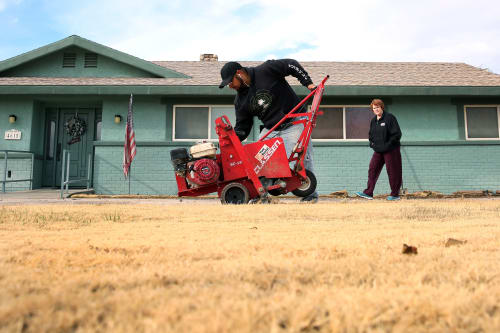uture growth in the Las Vegas Valley will rest almost entirely on the community’s ability to conserve its finite share of the Colorado River, water experts say.
How do they know this?
Because it’s already happening. Without the level of conservation the community has already achieved, Las Vegas would have run out of water more than a decade ago.
In 2002, valley residents and businesses soaked up a record 325,000 acre-feet of Colorado River water, 25,000 more than Nevada’s allotment from Lake Mead.
The extra water was available thanks to surplus guidelines adopted the previous year by the seven states that share the river. Local officials planned to use their share of the surplus to get them through 2003 and prop up their resource plan for at least a decade, until a new source could be brought online to slake the community’s growing thirst.
But something else happened in 2002: the driest year ever recorded on the river.
Dismal snowmelt from the mountains that feed the Colorado sent Lake Mead into free fall, forcing federal regulators to suspend the new surplus plans. All that extra water the community was counting on was gone almost overnight.
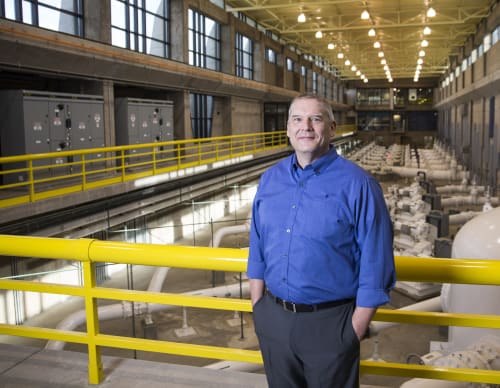
Southern Nevada Water Authority General Manager John Entsminger at Springs Preserve in Las Vegas in January 2019. (Benjamin Hager/Las Vegas Review-Journal)
“We had to turn on a dime,” said Southern Nevada Water Authority General Manager John Entsminger. “We had a 16-year hole in our resource plan within 12 months, and we had to implement a drought plan and ramp up looking at other stuff.”
The agency had a year to slash water use by about 8 billion gallons — 8 percent of its total — in a community that was adding 60,000 to 70,000 new residents and increasing water consumption by about 5 percent annually. It was the first big assignment for water authority conservation manager Doug Bennett.
“Suddenly we became very important,” Bennett said. “I don’t know if everybody in my organization would agree, but conservation loves a crisis.”
Watch: ‘Conservation loves a crisis’
Emergency response
The authority and its member utilities quickly adopted a slate of emergency drought measures, including seasonal watering restrictions and limits on fountains, misting systems and driveway car washing.
Lawns were banned in front of new homes and commercial buildings. Water waste enforcement was stepped up. Golf courses were forced to budget their water. And more money was plowed into the authority’s fledgling turf replacement program, which saw its rebate go from 40 cents to $1 for every square foot of grass converted to desert landscaping.
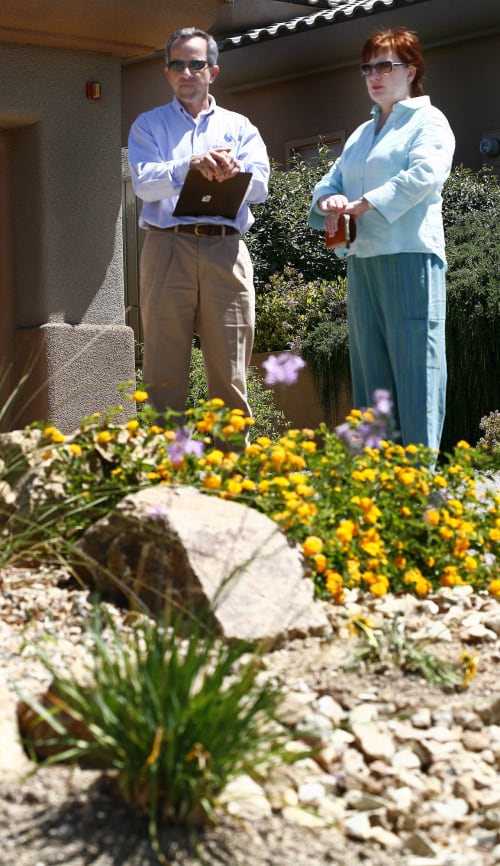
Southern Nevada Water Authority Conservation Manager Doug Bennett (left) looks over the front yard landscaping of homeowner Kathy Gillespie in May 2008. (Review-Journal file)
The results surprised even Bennett. In the first year, the growing community cut its water use by 15 percent, nearly double the targeted savings.
But former water authority chief Pat Mulroy said not everyone embraced the new conservation ethic right away.
“I had no idea the passion people in this community had around fountains. People in commercial buildings were yelling at me,” she said. “That and senior citizens and car washes. Never get between an old man and his car wash schedule. I thought they were going to come at me with canes.”
One west valley shopping center put up a sign claiming its fountain water was trucked in from Utah. “Then we caught their truck at a fire hydrant,” Mulroy said.
Another office park was forced to shut off its decorative babbling brook, so a psychiatrist renting an office there went on the local news to complain that he needed the sound of the water to calm his patients.
“I sent him a sound-soother CD,” Mulroy said.
Eventually, though, the community got on board.
Since 2002, Southern Nevada has added almost 650,000 new residents and 7 million annual visitors, all while decreasing overall water use by 26 percent and per capita consumption by 36 percent.
The emergency water-saving measures are now permanent, the word “drought” dropped from their name in favor of a different title: Water Smart.
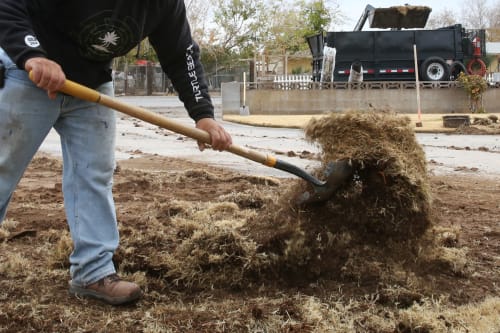
Pacas Rivera of Northwest Landscape removes old lawn from Mary Kiosowski Lewis' front yard in December 2018. (Bizuayehu Tesfaye/Las Vegas Review-Journal)
“All these programs have been around for 20 years now. People don’t want to debate them anymore,” Bennett said. “Nobody’s coming back and saying, ‘When can we start putting lawns in the front yards of new homes again?’ Everybody realizes that these were commonsense measures for the most part. What’s difficult for people is the change.”
Water in the streets
Of course, Southern Nevada might never have been able to cut its consumption so dramatically if it hadn’t been wasting so much water to begin with.
Mulroy said conservation was “like a foreign word” when she joined the Las Vegas Valley Water District in the mid-1980s.
The valley’s municipal utilities were trying to grab as much of the state’s Colorado River water as they could. “There was every disincentive built into that arrangement to not conserve,” Mulroy said.
The scramble grew so heated that officials in Boulder City “opened their fire hydrants and just let the water run down the street in order to ratchet up their Colorado River allocation,” she said. “I tell you, it was insanity.”
In 1991, Mulroy persuaded local water purveyors to set aside their differences and collectively manage river resources under the umbrella of the Southern Nevada Water Authority.
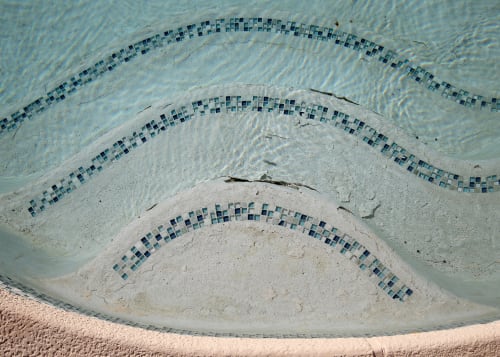
Cracked steps in a Las Vegas homeowner's pool. (K.M. Cannon/Las Vegas Review-Journal)
Not exactly
swimming in it
Grass gets all the bad publicity, but what about backyard pools?
“It surprises a lot of people, but swimming pools actually use slightly less water than turf,” said Southern Nevada Water Authority general manager John Entsminger.
And unlike what gets sprayed on lawns, at least some pool water might be reused, since local utilities require pools and spas to be drained into the sewer system, allowing the water to be recycled.
To cut down on evaporation and other waste, the authority offers rebates on pool covers and incentives on more efficient pool pumps.
For people who want to get rid of their in-ground pools altogether, the authority will treat the pool’s surface area like its grass and pay out turf-rebate money for the conversion, though it’s a lot more expensive to remove a pool than a lawn.
Generally speaking, authority officials feel the same way about swimming pools as they do about lawns: Both are an acceptable use of water, even in the desert, so long as they are actually being used for more than just decoration.
“If you’re not swimming in your pool, it’s a tremendous waste of water,” said authority conservation manager Doug Bennett. “So please, throw a party, invite people over, let the neighbors swim, … throw a ball for a Labrador retriever, let somebody get wet. Because otherwise you’re just sitting there watching evaporation.”
Even then, conservation played a minor role.
Former local TV reporter David Riggleman was hired as the authority’s first conservation manager in 1995, though not necessarily to curb overall water use. He said he was brought in to help reduce the community’s peak summer demand and prevent system capacity problems while the valley’s second water treatment plant and straw into Lake Mead were built.
“There wasn’t much of an appetite for (conservation) at first,” said Riggleman, now communications director for the city of Las Vegas.
His office did pilot an early version of what would become the turf rebate program — and promptly met roadblocks from builders and homeowners associations and resistance from residents. To a lot of people at the time, desert landscaping meant “rocks, cactus and a cow skull,” Riggleman said.
Bennett joined the authority in 2000 as Riggleman’s replacement.
For the first few years, he said, he ran several modest initiatives and oversaw a cumbersome water waste program that was issuing maybe 50 citations a year.
“Meanwhile, virtually every major street in this city was running like a river at 7 in the morning and 7 at night,” Bennett said. “It was a little discouraging, because it seemed like there wasn’t a strong drive to change things.”
Then came 2002 and the crisis that would finally spur Southern Nevada to get serious about conservation.
“To me, the most exciting thing was the way the community mobilized behind it,” Bennett said. “We went from being the poster child of squanderous waste to a conservation model for others to imitate.”
‘Fatigue’ slows progress
Stretching the water supply as far as possible is expected to take on added significance next year, when the authority could be forced to cutits annual Colorado River entitlement to help slow Lake Mead’s decline. Even before that, the seven Western states that draw water from the river face a March 19 federal deadline to submit plans to voluntarily trim their use on top of the mandatory cuts likely to kick in Jan. 1.
Lately, though, the conservation effort seems to have stalled.
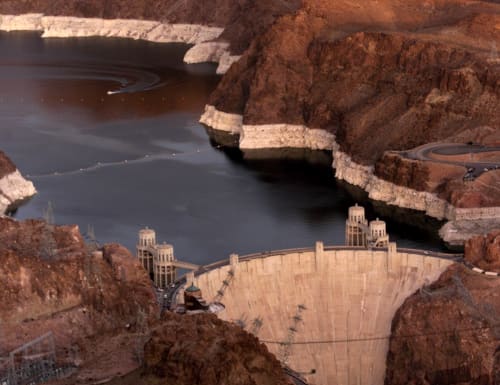
The water level at Lake Mead in 2002. That year was the driest year ever recorded on the Colorado river. (Review-Journal file)
Before drought took hold on the river, the valley’s per capita water use regularly topped 200 gallons a day. That shrank to about 127 gallons by 2013, but it hasn’t changed significantly since.
Bennett said “drought fatigue” might be to blame.
“We’ve been in drought so long that literally a child could have been born and become a voting adult and only known the lake to look as it looks today. It’s kind of hard to say, ‘It’s a drought. We need to get behind it. We need to marshal all our resources and efforts,’ when it’s all you’ve ever known,” he said.
The authority’s current conservation plan calls for per capita water use to drop to 116 gallons a day by 2035. It will take “more than what we’re doing right now” to reach and eventually exceed that goal, said Entsminger.
“The first half of any human endeavor is the easy half, right? The second half is always harder,” he added. “It’s time to ramp up our efforts.”
Step one came in December, when authority board members approved plans to increase the turf rebate amount from $2 to $3 per square foot and raise the size limit in hopes of enticing more large-scale landscape conversions.
By comparison, the Metropolitan Water District of Southern California, that state’s largest municipal water purveyor, voted in February to double its rebate to $2 for every square foot of grass removed.
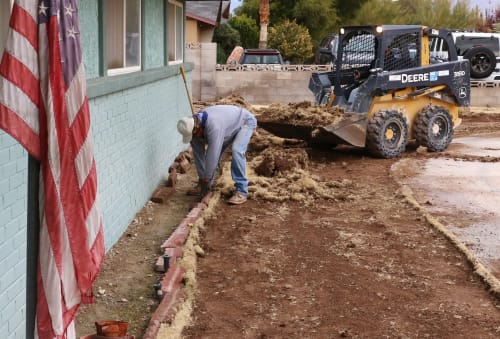
Rodolfo Ramos of Northwest Landscape removes old lawn from Mary Kiosowski Lewis' front yard in December 2018. Bizuayehu Tesfaye/Las Vegas Review-Journal)
One Las Vegas landscaper said the $3 rebate already seems to be working.
“We’re seeing a lot of the older homes that have larger areas starting to do their conversions,” said Jonathan Muirhead, who handles residential sales and design for Northwest Landscape and Maintenance.
It was definitely time to give the program a jolt, he said.
“A few years ago it was going pretty strong. We were doing a lot of them,” Muirhead said. “It’s slowed down a little bit.”
Aimed outdoors
The bulk of the renewed conservation push will take place outside, since the community already recycles all of its so-called “indoor water” — anything that goes down the drain and into the sewer system — by treating it and returning it to Lake Mead, where the authority can draw it back out on a gallon-for-gallon basis.
Entsminger said his agency is piloting new leak detection technology and investing in research to improve the efficiency of evaporative cooling systems, which consume more water at a typical Strip resort than all the landscaping, water features and swimming pools combined.
“Our community loses water two ways: outdoor irrigation and evaporative cooling,” he said. “If we could figure out a technology to make evaporative cooling much more efficient … that would be a huge way for this community to save additional water.”
Mulroy said there is a limit to what conservation can do. Eventually, “you’re going to hit a wall.” But Southern Nevada certainly hasn’t reached that point yet. Just drive the community and look at all the grass, she said. “There’s lots of opportunity left.”
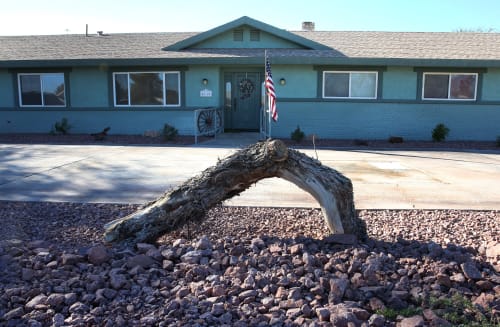
Desert-adapted plants and a low-maintenance front yard at Mary Kiosowski Lewis' home is seen in December 2018 in Las Vegas. (Bizuayehu Tesfaye/Las Vegas Review-Journal)
Longtime Las Vegas resident Larry Hines said he ripped out his front lawn about eight years ago. Now he’s getting rid of the grass in his backyard, too.
“It’s … to conserve water and to reduce my bill,” he said after dropping off his monthly payment recently at the Las Vegas Valley Water District office. “As far as the Colorado River and where it’s distributed, I don’t think anything can be done about that, so I think it’s up to the locals to make a change.”
Bennett said local water users have risen to the challenge before, and he’s confident they will again. All they need is some encouragement.
People have “an extraordinary resiliency and a capacity to do it if they feel motivated to get it done,” he said. “Really, that’s almost the story of this whole town. If something drives us, we do amazing things.”
Contact Henry Brean at hbrean@reviewjournal.com or 702-383-0350. Follow @RefriedBrean on Twitter.



